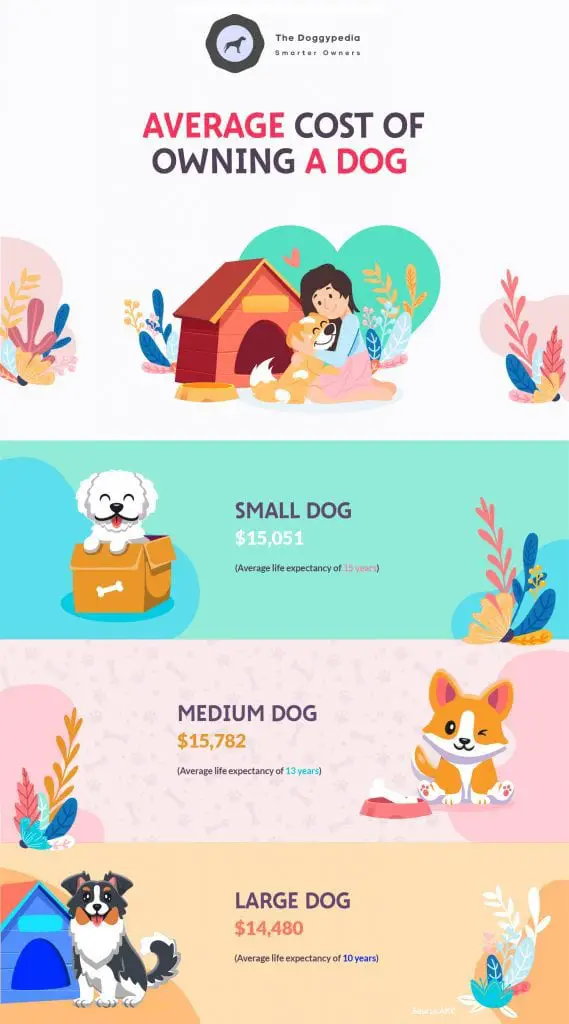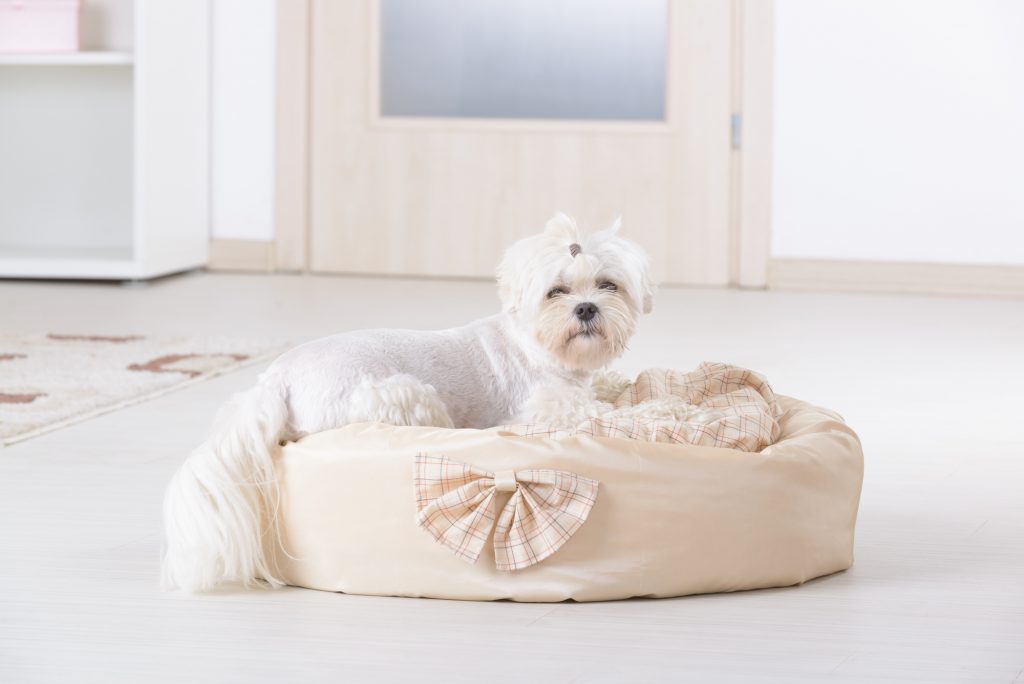Owning a dog can cost thousands of dollars over the years. You have to consider bigger expenses, like medical bills and adoption costs. However, you also have to consider things like food and toys, which can add considerably over the years.
It is important to budget for a dog appropriately before you adopt or purchase one from a breeder. After all, it can be considerably expensive, and you want to be prepared before the expenses start rolling in.
What is the total lifetime cost of owning a dog?
The lifetime cost of owning a dog can vary. After all, some dogs may be extremely healthy, while others might be generally healthy. The biggest expense will likely be medical expenses – at least all at one time. However, food and other regular expenses can also add up to a lot.
It also depends on the dog’s life expectancy. Larger dogs typically live shorter periods than smaller dogs. However, they tend to eat more overall, which can drive up the cost. You also have to consider things like grooming, which typically costs more for larger dogs.
Of course, there is no “official” overall cost for a dog. You can expect ownership to cost anywhere between $15,000 to $93,520. This is the cost to own a dog from puppyhood to their death. If you adopt an adult dog, it will likely be lower. The average for a larger dog will likely be on the lower side, while smaller dogs will be on the higher side – simply because they live longer.

One-Time Expenses vs. Recurring Expenses
Some expenses you will only need to pay once – like adoption and certain vet bills. These are usually quite high, but you only have to pay for them once. They might look like a lot of money upfront, but one-time expenses are usually not as high as recurring expenses over the lifespan of your dog.
Recurring expenses like food, toys, and treats are usually not terribly low upfront. However, you have to purchase them continuously. Over time, this lower cost can add up to thousands of dollars. If your dog is larger and eats more, you’re looking at even more money over the long-term. The same can be said for dogs that tend to tear up toys or use lots of treats for training.
Luckily, while recurring expenses add up to cost a lot, you don’t have to pay for them all at once. You shouldn’t need to save up to buy your dog’s food or a new toy. The upfront cost is quite low.
On the other hand, one-time expenses cost a lot up front, but you don’t have to worry about them again after paying for them. You may want to save up for these expenses. A pet emergency fund is perfect for unexpected, one-time expenses like emergency vet bills.
Cost Breakdown of Owning A Dog:
| Yearly Estimate | |
| Acquisition Cost: | $50 – $500 |
| Food: | $150 – $700 |
| Treats: | $200 – $500 |
| Toys: | $50 – $600 |
| Beds: | $50 – $80 |
| Leash and Collars: | $20 |
| Spay or Neuter: | $100 – $300 |
| Supplements: | $200 – $600 |
| Training: | $100 – $500 |
| Dog Walking and Pet Sitting: | $0 – $5,000 |
| Microchip: | $30 |
| Pet Insurance: | $180 – $360 |
| Average Monthly Cost: | $100 – $900 (normal health) |
| Yearly Cost: | $2,000 – $10,000 |
Acquisition Costs
Whether you’re adopting or purchasing a dog from a breeder, there will be some cost involved. Adopting a dog from a shelter typically costs anywhere from $50 – $150. Sometimes, this depends on what health services the shelter needed to provide for the dog. You may end up paying for vaccinations or surgeries the dog needed when they arrived.
Purchasing a puppy from a breeder is going to be considerably expensive. Most dog breeds cost around $1500. However, some can cost as much as $5000. Usually, dog breeds from champion lines cost more. Pet-quality dogs cost less, but they are still absolutely suitable for families.
In some cases, you may find a canine for free or at a meager cost through a social media website. Occasionally, you may also be able to find very cheap dogs at pet stores. However, we do not recommend purchasing from these stores or random breeders you find on the internet. If the dog is considerably cheaper than others of the same breed, you should be wondering why.
Typically, pet stores source their puppies from puppy mills. Puppy mills are facilities with lots of dogs that breed nearly constantly. Usually, they do not live in excellent conditions, are likely not purebreds (even if they are advertised as such), and the puppies and parents may not receive the proper care. Usually, these dogs are prone to health problems.
This is not the case for pet stores that source their dogs from adoption agencies. Many may work with local shelters and rescue agencies. However, if a pet store seems to mostly have puppies, they probably source their dog from a puppy mill.
If you purchase from a breeder, make sure they are certified by the AKC. The American Kennel Club ensures that breeders uphold certain standards. These breeders may be a bit more expensive, but that’s because they put more money into the care of their dogs.

Food & Treats
Food and treats can cost a decent bit of money – over time. Food cost will depend on how much your dog eats, which varies based on their age. Usually, you can expect to spend anywhere from $20 to $60 a month. Over the year, that can cost $250 to $700. In a lifetime, this can potentially be thousands of dollars.
Treats can be substantially expensive, depending on what you’re buying and the size of the dog. Some dogs may require as much as $50 worth of treats a month, especially when you’re first training them. Typically, the cost will decrease as dogs get older, as you won’t have to train them nearly as much.
Toys
Most dogs will be interested in toys, at least somewhat. Some might be a bit toy-obsessed, while others may just have one or two favorite toys over their lifetime. Some dogs may destroy toys, while others are extremely gentle.
The number of toys you need to buy depends on these few factors. For dogs that love toys and destroy them a lot, you may need to purchase up to $50 worth of toys a month. This can add up to $600 a year – not an unsubstantial cost at all!
In other cases, you may only be spending $50 a year. Older dogs usually don’t need that many toys, so the cost tends to go down as the dog ages.

Beds
Every dog should have a bed – even if they don’t use it all that much. The size of your dog will dictate how much the bed will cost. Bigger beds are more expensive! You can expect to pay anywhere from $20 to $80 on a decent dog bed.
Leashes and Collars
Your pet will also need a leash and a collar. In some cases, you may need multiple types of leashes for different situations. This shouldn’t cost all that much. You can buy a collar for less than $10, while a normal leash shouldn’t cost more than $20. If you purchase a more complicated leash, it will likely be more expensive.
Grooming
This cost will depend mostly on the breed. Some dogs may just need a $50 groomer’s visit every three months. Other dogs may need to go every month for rather expensive grooming – like Poodles, for instance.
In some cases, you may only need to spend $25 on a simple dog brush. Many smaller dogs with short coats don’t need regular trips to the groomer, so you should be able to do all of their grooming at home. Other dogs may cost upwards of $1,200 a year.
Veterinary Care
Some dogs may be incredibly healthy, while others might be significantly less so. You will have to pay for wellness visits, vaccinations, and dental care. This can cost anywhere from $200 to $1000, depending on what vaccinations your dog needs and the amount of dental care they require.
Emergencies and prescription medications will push this cost considerably higher. Chronic illnesses can be considerably expensive.
Spay or Neuter
This is one-time surgery costs a few hundred dollars. Dogs with some underlying health conditions may be a bit more expensive. All pet owners should plan on spaying or neutering their canine as soon as possible.
It may be better to wait until giant breeds are full grown, as fixing them too early can upset their hormones and cause health problems in the future.
Supplements
Not all dogs will need supplements, but most will have a little bit to gain from them. Larger dogs should take hip-supporting supplements, as these may prevent hip dyplasia and similar problems. Speak to your dog’s vet about potential hip problems your pooch might be experiencing.
Training Classes
Most pet owners should plan on taking their pooch to training classes. These classes are obviously good at helping train your canine, but they are also rather useful for socialization.
Training classes can cost anywhere from $100 to $500. Cost can depend on what trainer you’re using, what the class is set up is like, as well as how much help your dog needs. This will likely be a one-time cost, though some dogs may need to revisit classes later in their life.
Dog Walking
Not all dogs will need to be walked. In some cases, you won’t need a dog walker if your canines have access to a backyard or if you have time to walk your dog yourself. Your dog’s need also matters, as some need less exercise than others.
If you do need a dog walker, you can usually expect about $15 to $20 for a 20-minute walk. For two walks a day, you may get a small discount and pay between $30 to $45. Adding additional dogs isn’t going to cost very much. Most dog walkers will accept another dog for $5 to $10.

Pet Sitters
You will need a pet sitter at some point. You may just need someone to watch your dog for a night, or you may need your dog to be taken care of for a week or more. This adds substantial cost to a vacation, which is most likely when you’re need to leave your dog behind.
If your dog is well-trained, you will feel better about bringing them on vacation. You may be able to save a bit of money on pet sitting by training your canine – that way you won’t have to leave them alone as often.
Of course, even if they are well-trained, you will need to leave them at home occasionally. You can’t take a dog on a cruise!
Pet sitters usually cost anywhere from $25 to $85 a day. For a daily, 30-minute visit, you can expect to pay $25. Overnight fees are usually $75 to $85.
Unexpected Expenses
You should also add a bit in your budget for things that you may not think you need. Extra toys, a different grooming brush, furniture repairs, and dog books are all extras that you may not consider you need.
These extra will mostly occur in the beginning. You might need to purchase cleaning supplies for house training, for example. The cost of these items may vary from $50 to $300.
Microchip
You should also consider microchipping your canine. This is actually pretty cheap. You can find many vets that do microchips for as little as $15. Do it during a well visit so you don’t have to pay for another appointment.
Pet Insurance
We highly recommend pet insurance, especially if you don’t plan on having an emergency fund. Pet insurance can cost anywhere from $15 to $50 a month, depending on amount of coverage and other features you may need.
Emergency Fund
You should set aside at least $2000 for an emergency fund. This will cover things like medical expenses, as well as furniture repair, behavioral veterinary visits, and similar problems. This is for things that aren’t planned or budgeted for. You may want to increase the emergency fund at the beginning, as you won’t know your dog super well.
For example, you might purchase your dog some toys, only to find that they tear them up in only a few minutes. You may need to purchase new toys that are designed for heavy chewers. Or, you may find that you need to purchase a completely different food when your dog doesn’t like the first one you pick out. You may find yourself spending extra money at the beginning as you get used to your dog.

Which breeds are the most expensive and least expensive?
Bulldogs are extremely expensive. They are larger, eat a lot of food, and have quite a few health problems. Most of them will require quite a bit of care, especially when it comes to health. Mastiffs are also expensive, because they are so large. Chowchows require a lot of training, which can make them expensive.
The least expensive dogs will be those bred for practical purposes. Dogs bred for aesthetics for the most part will usually have health problems and may need extra care.
American Foxhounds are cheap to purchase and don’t have that many health problems. Dachshunds are not particularly expensive either and are great smaller, family dogs. They are prone to back problems, which are genetic. Coonhounds, beagles, and similar dogs are also pretty inexpensive.
Aim to purchase a dog that is from a practical, working-dog line. Show dogs tend to be more expensive and less healthy.
Consider How You Would Feel If You Can’t Afford to Care for Your Pet
Budgeting is the key to being able to take care of your pet successfully. If you don’t budget correctly, you run the risk of being unable to care for your pet. An emergency fund can be extremely helpful in this reason. If your financial situation changes, then you will likely be able to care for your dog for a bit out of the emergency fund.
You should also consider what you would do if you can’t care for your dog any longer for whatever reason. Having a rescue in mind you can call or a local shelter you know the location of can be extremely helpful.
